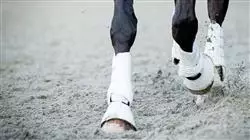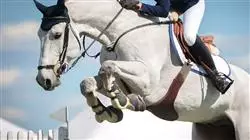University certificate
The world's largest faculty of veterinary medicine”
Introduction to the Program
With this comprehensive Master's Degree, you will learn how to effectively aid equines to recover from their injuries"

The Master's Degree in Equine Rehabilitation is based on the experience of several internationally renowned rehabilitation specialists, as well as overarching scientific analysis of rehabilitation, and includes information that cannot be found in any other online or classroom program, delivered by a faculty of the highest level.
Over the course of this program, three fundamental pillars for in-depth knowledge of rehabilitation are addressed: functional anatomy and biomechanics, as well as adaptation to exercise and physiological changes; physiotherapy techniques, application, methodology and effectiveness; and the analysis of the different injuries treatable with physiotherapy, their diagnosis, treatment and prognosis.
The contents of this program are based on real experience, scientific evidence and practical application. The objective is to enable students to develop rehabilitation plans and physiotherapy treatments with a solid foundation that ensures success in both planning and execution.
In conclusion, the Master's Degree in Equine Rehabilitation is a comprehensive and well-founded program, with renowned and experienced international experts in the field, who will provide the student with high level professional development in a discipline that has become essential in equine medicine.
This Master's Degree provides students with specialised tools and skills to successfully practise in the broad field of Equine Rehabilitation, working on key competencies such as knowledge of the day-to-day work of the Veterinary professional, and responsibility in the monitoring and supervision of their work, as well as communication skills for effective teamwork.
As it is an online program, students will not be bound by fixed schedules or the need to move to another physical location, but rather, they can access the content at any time of the day, balancing their professional or personal life with their academic life.
Do not miss the opportunity to take this Master's Degree in Equine Rehabilitation with us. It's the perfect opportunity to advance your career"
This Master's Degree in Equine Rehabilitation contains the most complete and up-to-date scientific program on the market. The most important features include:
- Case studies presented by experts in Equine Rehabilitation
- Graphic, schematic, and practical contents which provide scientific and practical information on the disciplines that are essential for professional practice
- The latest news on Equine Rehabilitation
- Practical exercises where self-assessment can be undertaken to improve learning
- A special emphasis on innovative methodologies for Equine Rehabilitation
- Theoretical lessons, questions to the expert, debate forums on controversial topics, and individual reflection assignments
- Content that is accessible from any fixed or portable device with an Internet connection
This Master's Degree is the best investment you can make when choosing a program to update your existing knowledge of Equine Rehabilitation"
The faculty includes veterinary professionals who bring their professional experience to the program, as well as renowned specialists from leading societies and prestigious universities.
The multimedia content, developed with the latest educational technology, will provide the professional with situated and contextual learning, i.e., a simulated environment that will provide immersive learning designed for real situations.
This program is designed around Problem-Based Learning, whereby the professional must try to solve the different professional practice situations that arise throughout the program. For this purpose, the professional will be assisted by an innovative interactive video system developed by renowned and experienced experts in Equine Rehabilitation.
This program comes with the best educational material, providing you with a contextual approach that will facilitate your learning"

This 100% online Master's Degree will allow you to combine your studies with your professional work while building on your knowledge in this field"
Why study at TECH?
TECH is the world’s largest online university. With an impressive catalog of more than 14,000 university programs available in 11 languages, it is positioned as a leader in employability, with a 99% job placement rate. In addition, it relies on an enormous faculty of more than 6,000 professors of the highest international renown.

Study at the world's largest online university and guarantee your professional success. The future starts at TECH”
The world’s best online university according to FORBES
The prestigious Forbes magazine, specialized in business and finance, has highlighted TECH as “the world's best online university” This is what they have recently stated in an article in their digital edition in which they echo the success story of this institution, “thanks to the academic offer it provides, the selection of its teaching staff, and an innovative learning method aimed at educating the professionals of the future”
A revolutionary study method, a cutting-edge faculty and a practical focus: the key to TECH's success.
The most complete study plans on the university scene
TECH offers the most complete study plans on the university scene, with syllabuses that cover fundamental concepts and, at the same time, the main scientific advances in their specific scientific areas. In addition, these programs are continuously being updated to guarantee students the academic vanguard and the most in-demand professional skills. In this way, the university's qualifications provide its graduates with a significant advantage to propel their careers to success.
TECH offers the most comprehensive and intensive study plans on the current university scene.
A world-class teaching staff
TECH's teaching staff is made up of more than 6,000 professors with the highest international recognition. Professors, researchers and top executives of multinational companies, including Isaiah Covington, performance coach of the Boston Celtics; Magda Romanska, principal investigator at Harvard MetaLAB; Ignacio Wistumba, chairman of the department of translational molecular pathology at MD Anderson Cancer Center; and D.W. Pine, creative director of TIME magazine, among others.
Internationally renowned experts, specialized in different branches of Health, Technology, Communication and Business, form part of the TECH faculty.
A unique learning method
TECH is the first university to use Relearning in all its programs. It is the best online learning methodology, accredited with international teaching quality certifications, provided by prestigious educational agencies. In addition, this disruptive educational model is complemented with the “Case Method”, thereby setting up a unique online teaching strategy. Innovative teaching resources are also implemented, including detailed videos, infographics and interactive summaries.
TECH combines Relearning and the Case Method in all its university programs to guarantee excellent theoretical and practical learning, studying whenever and wherever you want.
The world's largest online university
TECH is the world’s largest online university. We are the largest educational institution, with the best and widest online educational catalog, one hundred percent online and covering the vast majority of areas of knowledge. We offer a large selection of our own degrees and accredited online undergraduate and postgraduate degrees. In total, more than 14,000 university degrees, in eleven different languages, make us the largest educational largest in the world.
TECH has the world's most extensive catalog of academic and official programs, available in more than 11 languages.
Google Premier Partner
The American technology giant has awarded TECH the Google Google Premier Partner badge. This award, which is only available to 3% of the world's companies, highlights the efficient, flexible and tailored experience that this university provides to students. The recognition as a Google Premier Partner not only accredits the maximum rigor, performance and investment in TECH's digital infrastructures, but also places this university as one of the world's leading technology companies.
Google has positioned TECH in the top 3% of the world's most important technology companies by awarding it its Google Premier Partner badge.
The official online university of the NBA
TECH is the official online university of the NBA. Thanks to our agreement with the biggest league in basketball, we offer our students exclusive university programs, as well as a wide variety of educational resources focused on the business of the league and other areas of the sports industry. Each program is made up of a uniquely designed syllabus and features exceptional guest hosts: professionals with a distinguished sports background who will offer their expertise on the most relevant topics.
TECH has been selected by the NBA, the world's top basketball league, as its official online university.
The top-rated university by its students
Students have positioned TECH as the world's top-rated university on the main review websites, with a highest rating of 4.9 out of 5, obtained from more than 1,000 reviews. These results consolidate TECH as the benchmark university institution at an international level, reflecting the excellence and positive impact of its educational model.” reflecting the excellence and positive impact of its educational model.”
TECH is the world’s top-rated university by its students.
Leaders in employability
TECH has managed to become the leading university in employability. 99% of its students obtain jobs in the academic field they have studied, within one year of completing any of the university's programs. A similar number achieve immediate career enhancement. All this thanks to a study methodology that bases its effectiveness on the acquisition of practical skills, which are absolutely necessary for professional development.
99% of TECH graduates find a job within a year of completing their studies.
Master's Degree in Equine Rehabilitation
In areas where horses live, strategic primary care plans must be implemented to ensure the health and well-being of the animals. One of the greatest challenges for veterinarians is to effectively implement comprehensive recovery programs that meet the animals' healthcare needs. While these strategies are not new, they have seen significant advancements over the years, which means professionals need to acquire updated knowledge to improve their practice and provide high-quality care. At TECH Global University, we have designed a Master's Degree in Equine Rehabilitation that, in addition to covering the latest developments in this field, includes the foundational pillars of functional anatomy and biomechanics, allowing specialization in the area of rehabilitation. This program will enable you to establish assessment parameters to evaluate the animal's overall functionality and create effective physiotherapy plans and treatments to reduce pain and dysfunction.
Specialize in equine injury rehabilitation
Through this one-year, online postgraduate program, you will learn veterinary physiotherapy techniques such as manual and active therapy, kinesiotherapy, and electrophysical agents (analgesic electrotherapy, percutaneous electrolysis, diathermy, therapeutic laser, and shockwave therapy), as well as their application, methodology, and effectiveness in treating susceptible injuries. You will also study the assessment and functional planning of rehabilitation, exercise physiology, and training, followed by complementary modalities (neuromuscular taping and acupuncture) to treat respiratory, cardiovascular, and musculoskeletal pathologies in horses, whether from farms and breeding operations or used in equestrian sports.
Study at the world's largest online School of Veterinary Medicine
The curriculum for this Master's program is designed with the latest educational technology, and you will benefit from theoretical and practical lessons taught by a faculty with extensive experience in the field. As this is an online program, you will be able to study remotely and manage your learning schedule in a way that best fits your needs. By the end of the course, you will be an expert in diagnosing and monitoring injuries from pathologies, re-educating motor control (core training), and conducting functional evaluations to restore the animal’s natural gaits (walk, trot, and gallop).







